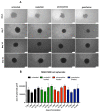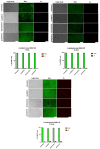Chondral/Desmal Osteogenesis in 3D Spheroids Sensitized by Psychostimulants
- PMID: 36294540
- PMCID: PMC9605537
- DOI: 10.3390/jcm11206218
Chondral/Desmal Osteogenesis in 3D Spheroids Sensitized by Psychostimulants
Abstract
Attention deficit hyperactivity disorder (ADHD) affects 6.4 million children in the United States of America. Children and adolescents, the main consumers of ADHD medication, are in the bone growth phase, which extends over a period of up to two decades. Thus, impaired proliferation and maturation of chondrocytes and osteoblasts can result in impaired bone formation. The aim of this study is to investigate, for the first time, the effects of the ADHD-medication modafinil, atomoxetine and guanfacine on bone growth and repair in vitro. Using two-dimensional and three-dimensional cell models, we investigated the chondrogenic/osteogenic differentiation, proliferation and viability of human mesenchymal progenitor cells. Real-time cell proliferation was measured by xCELLigence. Live/dead staining and size measurement of hMSC- and MG63 monolayer and spheroids were performed after administration of therapeutic plasma concentrations of modafinil, atomoxetine and guanfacine. Chondrogenic differentiation was quantified by RTqPCR. The chondrogenic and osteogenic differentiation was evaluated by histological cryo-sections. Modafinil, atomoxetine and guanfacine reduced chondrogenic and osteogenic differentiation terms of transcript expression and at the histological level. Cell viability of the MG63- and hMSC monolayer was not impeded by ADHD-medication. Our in vitro results indicate that modafinil, atomoxetine and guanfacine may impair chondrogenic and osteogenic differentiation in a 3D model reflecting the in vivo physiologic condition.
Keywords: bone defect; cell spheroids ADHD; cell viability; hMSCs; osteogenic/chondrogenic differentiation.
Conflict of interest statement
The authors declare that they have no conflict of interest.
Figures











Similar articles
-
Psychostimulants Modafinil, Atomoxetine and Guanfacine Impair Bone Cell Differentiation and MSC Migration.Int J Mol Sci. 2022 Sep 6;23(18):10257. doi: 10.3390/ijms231810257. Int J Mol Sci. 2022. PMID: 36142172 Free PMC article.
-
Pre-culture of human mesenchymal stromal cells in spheroids facilitates chondrogenesis at a low total cell count upon embedding in biomaterials to generate cartilage microtissues.Acta Biomater. 2022 Apr 15;143:253-265. doi: 10.1016/j.actbio.2022.02.038. Epub 2022 Mar 1. Acta Biomater. 2022. PMID: 35240315
-
Spheroid model for functional osteogenic evaluation of human adipose derived stem cells.J Biomed Mater Res A. 2017 Apr;105(4):1230-1236. doi: 10.1002/jbm.a.35974. Epub 2017 Feb 2. J Biomed Mater Res A. 2017. PMID: 27943608 Free PMC article.
-
Practitioner Review: Pharmacological treatment of attention-deficit/hyperactivity disorder symptoms in children and youth with autism spectrum disorder: a systematic review and meta-analysis.J Child Psychol Psychiatry. 2021 Jun;62(6):680-700. doi: 10.1111/jcpp.13305. Epub 2020 Aug 26. J Child Psychol Psychiatry. 2021. PMID: 32845025
-
Guanfacine Extended Release: A New Pharmacological Treatment Option in Europe.Clin Drug Investig. 2016 Jan;36(1):1-25. doi: 10.1007/s40261-015-0336-0. Clin Drug Investig. 2016. PMID: 26585576 Free PMC article. Review.
Cited by
-
Enhancing Bone Formation Through bFGF-Loaded Mesenchymal Stromal Cell Spheroids During Fracture Healing in Mice.Bioengineering (Basel). 2024 Oct 18;11(10):1041. doi: 10.3390/bioengineering11101041. Bioengineering (Basel). 2024. PMID: 39451415 Free PMC article.
References
-
- Science Direct: Endochondral Ossification. [(accessed on 16 June 2022)]. Available online: https://www.sciencedirect.com/topics/veterinary-science-and-veterinary-m....
LinkOut - more resources
Full Text Sources

